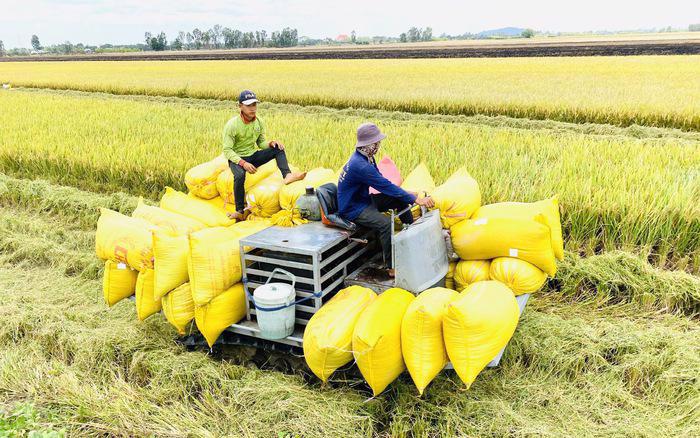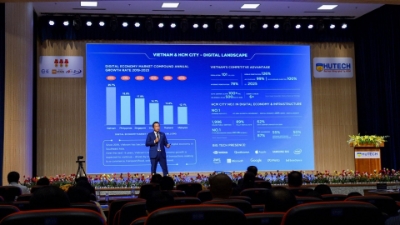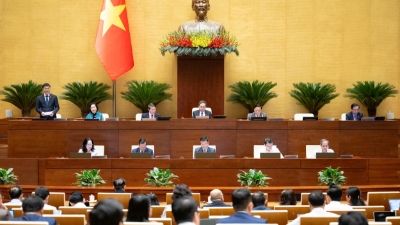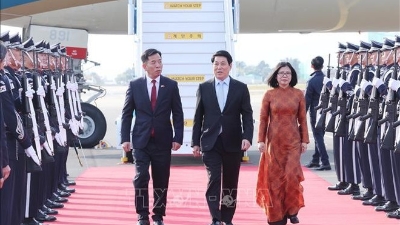According to Mr. Nguyen Anh Son, Director General of the Department of Import and Export at the Ministry of Industry and Trade (MoIT), Vietnam is one of the three largest rice exporters in the world, accounting for approximately 15 per cent of the global total. Therefore, he said, any changes in policy, fluctuations in supply and demand, and price trends in importing countries will directly affect Vietnam’s rice export.
Major export potential
Vietnam’s rice industry has enhanced its profile and expanded its markets to over 180 countries and territories. Of particular note, challenging destinations such as Europe, the US, South Korea, Australia, and the Middle East have shown a preference for high-quality rice from Vietnam. Its rice exports set a record in 2023, with shipments of more than 8.1 million tons and revenue of $4.78 billion, a 36.6 per cent increase in value compared to 2022. It was also the highest volume for many years, indicating rapid growth and significant transformation in both production and exports.
Mr. Nguyen Ngoc Nam, President of the Vietnam Food Association, quoted data from the US Department of Agriculture as saying that Vietnam was ranked third after India (17.5 million tons) and Thailand (8.8 million tons) in terms of rice exports globally in 2023. This is a remarkable achievement for the country’s rice sector, affirming its status as one of the world’s top 3 rice exporters.
Alongside these achievements, however, Mr. Nam also pointed out that the profitability of rice exporters remains relatively low due to rising production costs and service fees, which pushes up overall costs in the domestic market.
In terms of exports, he predicts that the market will become more vibrant as demand from major markets such as Indonesia, the Philippines, Malaysia, China, and Africa increases due to concerns about a prolonged El Nino weather pattern until the middle of the year. Based on such developments, the Vietnam Food Association plans to export approximately 6.5 million tons of rice this year.
Despite the global challenges, Mr. Son believes that rice exports have exhibited positive signs in the early months of 2024. Specifically, in January, rice exports stood at $362 million, an increase of 7 per cent compared to the same period last year. Additionally, according to several forecasts, rice prices will continue to rise throughout the year due to supply constraints.
“The market is expected to tighten at the beginning of the year due to existing export restrictions in India,” he commented, adding that the start of the El Nino weather pattern and the potential impact of this phenomenon on key rice-growing areas have further raised concerns about supply. At the same time, he emphasized that this presents a great opportunity for the rice industry and businesses in Vietnam. However, he added, opportunities are always accompanied by challenges. It is therefore crucial for the government to make greater efforts, while rice exporters must be proactive in research, closely monitor the market, and ensure sustainable and effective operations.
Growing markets
To develop rice export markets, Mr. Nam proposed that the Ministry of Industry and Trade (MoIT) provide timely information on export figures as a basis for relevant parties to balance supply and demand more effectively; intensify research into the market, with assessments and forecasts on import needs and the capacity to conduct marketing promotion activities in import markets; and provide updated information for the Association and exporters to prepare trade strategies and export plans. At the same time, negotiations must be conducted and preferential trade agreements with potential export markets signed, and reviews conducted of existing agreements to ask partners to open up further and increase quotas for Vietnam. Communications also need to be strengthened to raise awareness among traders about regulations in new generation free trade agreements and bilateral agreements to maximize quotas subject to tariff preferences.
Mr. Ha Vu Son, Director of the Can Tho Department of Industry and Trade in the Mekong Delta city of Can Tho, said the city is a hub and production center for rice production and export in the local region. In 2023, rice exports totaled 976,260 tons, worth $520.91 million, an increase of 23.23 per cent in value compared to the previous year. There are 37 eligible enterprises participating directly in rice exports in the city, with a storage capacity of 405,380 tons of paddy rice and 756,802 tons of milled rice. There are also 45 milling plants with a combined capacity of 1,017 tons of paddy rice an hour, and 58 polishing and whitening facilities also with a combined capacity of 1,017 tons of milled rice an hour. Joining these are several milling and processing facilities supplying rice exporters and domestic businesses. Primary export markets include the Philippines, Malaysia, Ghana, Cameroon, the Ivory Coast, South Africa, Australia, Singapore, China, and Qatar, among others.
Can Tho has maintained its production volume and export value thanks to its high-quality rice. The composition of its export products has changed, with fragrant rice accounting for a growing share. Some companies have invested in raw material areas using high-quality rice varieties, to meet customer requirements, and have invested in inputs for farmers to ensure quality and price, while purchasing products at relatively favorable prices from those involved in joint production. As of February 22, inventories were estimated at 119,524 tons of paddy rice and 245,799 tons of milled rice, with white rice accounting for 25.59 per cent, fragrant rice 43.64 per cent, and Japonica 7.09 per cent.
To boost rice production and exports while ensuring food security, Can Tho has proposed that the MoIT strengthen the implementation of programs, trade promotion activities, and marketing for Vietnamese rice. It should also guide rice exporters in enhancing production capacity, trade capabilities, negotiation skills, contract execution, and the efficient handling of international commercial disputes, thus improving the reputation and brand value of Vietnamese rice in the global market.
The Ministry should also continue implementing measures to diversify export markets with stable, sustainable product offerings, reinforce traditional export markets, prioritize key markets, develop new markets, increase Vietnam’s market share in importing countries, and affirm the credibility and brand value of Vietnamese rice.
Its proposal also suggests that the MoIT recommend that the State Bank of Vietnam (SBV) direct credit institutions to focus resources and expand loan limits to meet capital needs in the rice industry, at reasonable interest rates, flexibly apply various forms of loan guarantees, and continue improving the lending process and procedures to facilitate access to credit for businesses. At the same time, the SBV should actively identify and introduce solutions to ease difficulties facing businesses.
Mr. Nguyen Thanh Huynh, Deputy Director of the An Giang Department of Industry and Trade in the Mekong Delta province of An Giang, proposed that the Ministry establish a rapid information channel on foreign rice import requirements, which would provide enterprises with proactive pricing information during negotiations and future contracts. An Giang, along with local businesses, is implementing a project to build and develop the An Giang rice brand by 2025 with a vision to 2030. After producing branded rice products, the province hopes that the MoIT will help it with promoting and stimulating sales, contributing to increasing the value of the province’s rice products.









 Google translate
Google translate